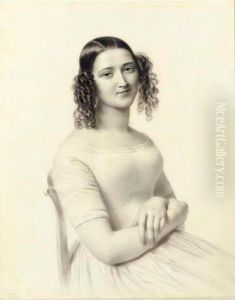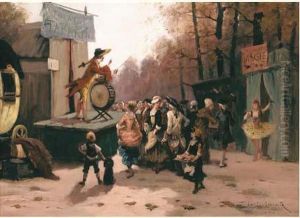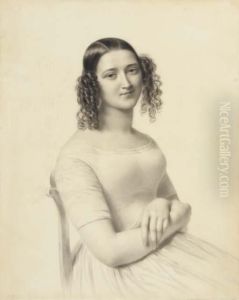Hyacinthe Louis V. Aubry-Lecomte Paintings
Hyacinthe Louis Victor Jean Baptiste Aubry-Lecomte, known as Hyacinthe Aubry-Lecomte, was a French lithographer and painter born on June 2, 1787, in Pons, Charente-Maritime. His artistic endeavors were primarily centered around lithography, a printmaking technique that was relatively new at the time and involved drawing images on limestone with oil-based ink.
Aubry-Lecomte was initially trained in law before he turned towards art. His transition to art was influenced by the thriving cultural scene in France during the post-revolutionary period. He studied under the painter Jacques-Louis David, who was a leading figure in the neoclassical movement. Under David's tutelage, Aubry-Lecomte honed his skills in drawing and composition, which would later be fundamental to his lithographic works.
He made a name for himself as a lithographer with his reproductions of famous paintings, particularly those by his contemporaries such as Ingres. His works were noted for their high level of detail and the quality of his technique. Aubry-Lecomte's lithographs were often featured in salons and exhibitions, earning him considerable acclaim. Among his famous works were his lithographs of Ingres's paintings 'La Grande Odalisque' and 'Oedipus and the Sphinx.'
Aubry-Lecomte was also known for his portraits. He created lithographs of several notable figures of his time, including the French writer Victor Hugo and the composer Gioachino Rossini. These portraits were celebrated for their likeness and expressive quality, showcasing Aubry-Lecomte's skill in capturing the character and essence of his subjects.
Despite the success of his lithographs, Aubry-Lecomte also faced challenges common to many artists of his era, including financial instability and the changing tastes of the art-buying public. Nevertheless, he continued to work and contribute to the development of lithography as an art form throughout his life.
Hyacinthe Louis Victor Jean Baptiste Aubry-Lecomte died on February 14, 1858, in Paris. Although not as widely known today as some of his contemporaries, his contributions to lithography and his skillful reproductions of neoclassical works have ensured him a place in the history of French art. His works can be found in various museums and collections, where they continue to be studied and appreciated by art historians and enthusiasts alike.


